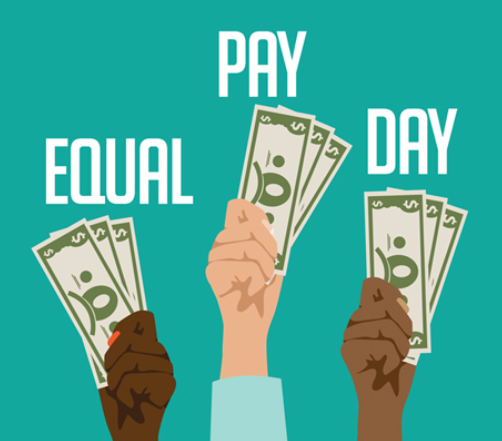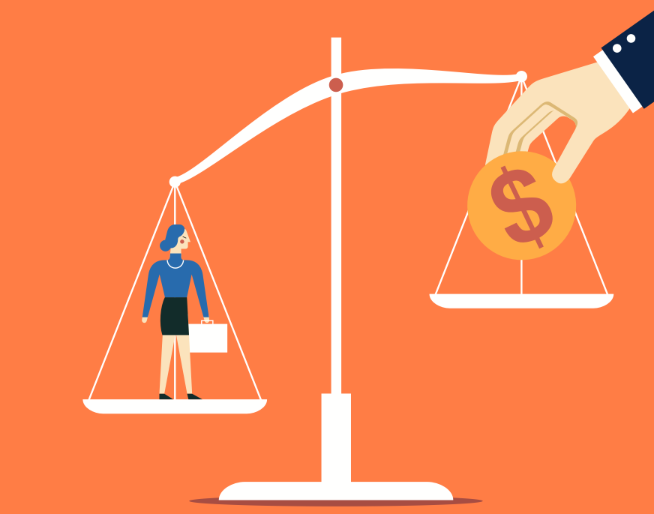In a world that champions equality and justice, disparities in income across genders remain a glaring and persistent issue. Equal Pay Day is not just another date on the calendar but a powerful symbol of this ongoing struggle.
Today, the average woman’s earnings “catch up” to what the average man earned the previous year, illuminating the gender wage gap in stark, tangible terms.
As an annual reminder, Equal Pay Day underscores the substantial pay disparities between genders and amplifies the urgent call for pay equity.
Its purpose? To bring to the forefront a conversation that often simmers below the surface of our everyday lives: the crucial need to recognize and rectify pay inequities between men and women.
Join us as we delve deeper into the significance of Equal Pay Day, the reasons behind its inception, and the importance of ensuring a fair wage system for everyone, regardless of gender.
Understanding the Gender Wage Gap
The gender wage gap refers to the relative difference in average earnings between men and women. It is a metric that captures the discrepancies in pay for similar roles and qualifications, often revealing a pattern where women, on average, earn less than their male counterparts.
But this isn’t just about numbers; the wage gap symbolizes a broader spectrum of societal issues, from ingrained biases to institutional barriers women face in the workplace.
The Stark Reality of Numbers
According to data from the U.S. Census Bureau (as of 2021), women working full-time, year-round earned, on average, only 82 cents for every dollar earned by men. This translates to an 18% wage gap. However, this is a broad average, and variations arise when we delve deeper into the data.
1. Age: Younger women, particularly those between 20-24 years old, experience a smaller wage gap than women in their prime working years. However, as age increases, so does the disparity, with women aged 45-64 facing a more pronounced wage gap than their younger counterparts.
2. Race and Ethnicity: The wage gap is not uniform across racial and ethnic lines. As of the latest data, Asian women have the smallest wage gap relative to white men, earning 87 cents on the dollar. However, Black women earn 63 cents, Native American women earn 60 cents, and Hispanic or Latina women face the largest disparity, earning only 55 cents for every dollar a white man earns.
3. Educational Attainment: Higher education often leads to higher wages but does not necessarily close the wage gap. The gap is wider for those with bachelor’s degrees or higher than those with only a high school education.
4. Occupation: The gap exists across various sectors and job types. For instance, the wage gap is more pronounced in traditionally male-dominated professions like finance or engineering. Conversely, the gap is narrower but still present in sectors like education or health services.
Origin and Significance of Equal Pay Day
To truly grasp the weight of Equal Pay Day, one must journey back to its inception and recognize the deliberate thought that went into marking this day.
A Brief History
Equal Pay Day was introduced in 1996 by the National Committee on Pay Equity (NCPE), an alliance of women’s and civil rights organizations, labor unions, and professional associations.
The primary intention was to create a public awareness event to draw attention to the gap between men’s and women’s wages. With its initiation, the day started making annual appearances on our calendars, steadily growing in prominence and resonance across the globe.
Calculation and Variability
The exact date of Equal Pay Day varies each year, representing the extra time a woman must work to earn what a man made in the previous year. It’s a stark reminder that, on average, women have to venture into the next year to attain parity with men’s earnings from the year prior.
The calculation has been historically anchored around the figure of 77 cents on the dollar, which was the prevailing wage gap at the time of the event’s inception. Thus, if a man made a dollar in a calendar year, a woman, on average, would make about 77 cents, taking her well into the next year to match his earnings.
However, as noted in the previous section, this gap fluctuates based on age, race, occupation, and more factors. As a result, the date of Equal Pay Day can shift slightly each year, reflecting the current state of the wage gap.
This year, the Equal Pay Day date will be November 2, 2023.
The Profound Significance
While the primary objective of Equal Pay Day is to highlight wage discrepancies, its significance runs deeper. It is a testament to the larger issues at play: systemic gender bias, societal norms that stifle women’s progression in workplaces, and deeply entrenched inequalities.
By earmarking a specific day each year, Equal Pay Day is a poignant reminder of the work yet to be done, pushing societies, organizations, and governments worldwide toward more equitable and just practices.

Key Factors Contributing to the Gender Wage Gap
To effectively address and ultimately bridge the gender wage gap, it’s essential to understand its root causes. Here’s a deeper dive into the major factors contributing to this persistent disparity:
1. Occupational Segregation
Occupational segregation refers to concentrating one gender in particular industries or roles. For instance, nursing and primary education have traditionally been female-dominated, while sectors like engineering or finance are male-dominated. These patterns can lead to wage disparities, especially if male-dominated fields generally offer higher wages.
Why Does This Happen? Societal and cultural factors play a pivotal role. From a young age, children receive cues about “appropriate” careers for their gender. Over time, these early influences shape educational choices and career paths. This societal molding is reinforced by stereotypes, media portrayals, and sometimes educational institutions.
2. Motherhood Penalty
The term “motherhood penalty” describes the economic disadvantages working women often face after becoming mothers. Career interruptions—like maternity leave or reduced working hours—to cater to family needs can slow career progression and affect long-term earnings.
The Broader Perspective: Beyond direct wage impacts, mothers frequently face biases in the workplace, being perceived as less committed or competent. To counteract this, there’s a pressing need for more family-friendly policies, flexible working hours, and strong support systems for working mothers, ensuring they’re not unfairly penalized for their dual roles.
3. Discrimination and Bias
Despite numerous strides in gender equality, discrimination remains a stark reality. Both conscious and unconscious biases can influence hiring decisions, promotions, and salary negotiations.
For example, women might be passed over for leadership roles based on unfounded perceptions about their ability to handle “pressure” or their commitment post-childbirth.
4. Negotiation Disparities
Research consistently shows that women, on average, tend to negotiate salaries less aggressively than men. One study from Harvard University revealed that women are less likely to initiate negotiations, and when they do, they often ask for less than their male counterparts.
Unpacking the Reasons: Societal expectations play a significant part here. Women often face backlash when displaying assertiveness or ambition, traits frequently rewarded in men. The fear of being perceived as “too aggressive” or “not likable” can deter women from pushing for higher pay, further exacerbating the wage gap.
Activities and Advocacy on Equal Pay Day
Equal Pay Day is not a passive observation on the calendar; it’s a dynamic and resounding call to action. Every year, this symbolic day galvanizes individuals, organizations, and policymakers alike, resulting in a host of activities that amplify the urgent demand for pay equity. Here’s a glimpse into how Equal Pay Day reverberates around the world:
1. Events and Seminars
Educational events, workshops, and seminars take center stage on Equal Pay Day. They offer platforms for experts to dissect the intricacies of the wage gap, share insights on the latest research, and present potential solutions. These events can range from local community meet-ups to international conferences, bringing together diverse voices committed to the cause.
2. Social Media Campaigns
In the digital age, the reach of social media is unparalleled. Hashtags related to Equal Pay Day often trend, sparking online conversations that can span continents. Organizations and influencers alike share infographics, videos, and stories that shed light on the wage gap’s real-world implications. Such campaigns educate and mobilize netizens, turning passive onlookers into active advocates.
3. Open Discussions and Panel Talks
Open forums, often hosted by academic institutions or corporate entities, facilitate candid discussions on pay equity. These discussions highlight macro and micro perspectives on the issue by featuring a mix of panelists—from industry leaders to grassroots activists.
4. Activists and Organizations at the Forefront
Equal Pay Day owes much visibility to relentless activists and organizations dedicated to gender equity. These champions often launch campaigns, lead rallies, and liaise with media outlets to ensure that the message of pay equity reaches the masses. Their unyielding advocacy often serves as a bridge between grassroots movements and legislative change.
5. Policymaker Involvement
Recognizing the gravity of the issue, many policymakers and political figures mark Equal Pay Day by advocating for reforms, endorsing supportive legislation, or announcing new initiatives to bridge the wage gap.
Conclusion
Equal Pay Day is a potent confluence of advocacy, education, and action. Through the myriad activities that mark this day, the message is clear: the gender wage gap is not just a statistic but a pervasive issue that demands collective attention and action. By uniting voices from all walks of life—from a student tweeting about pay equity to a lawmaker drafting reforms—Equal Pay Day is a powerful reminder that the journey toward pay equity is both shared and imperative.



